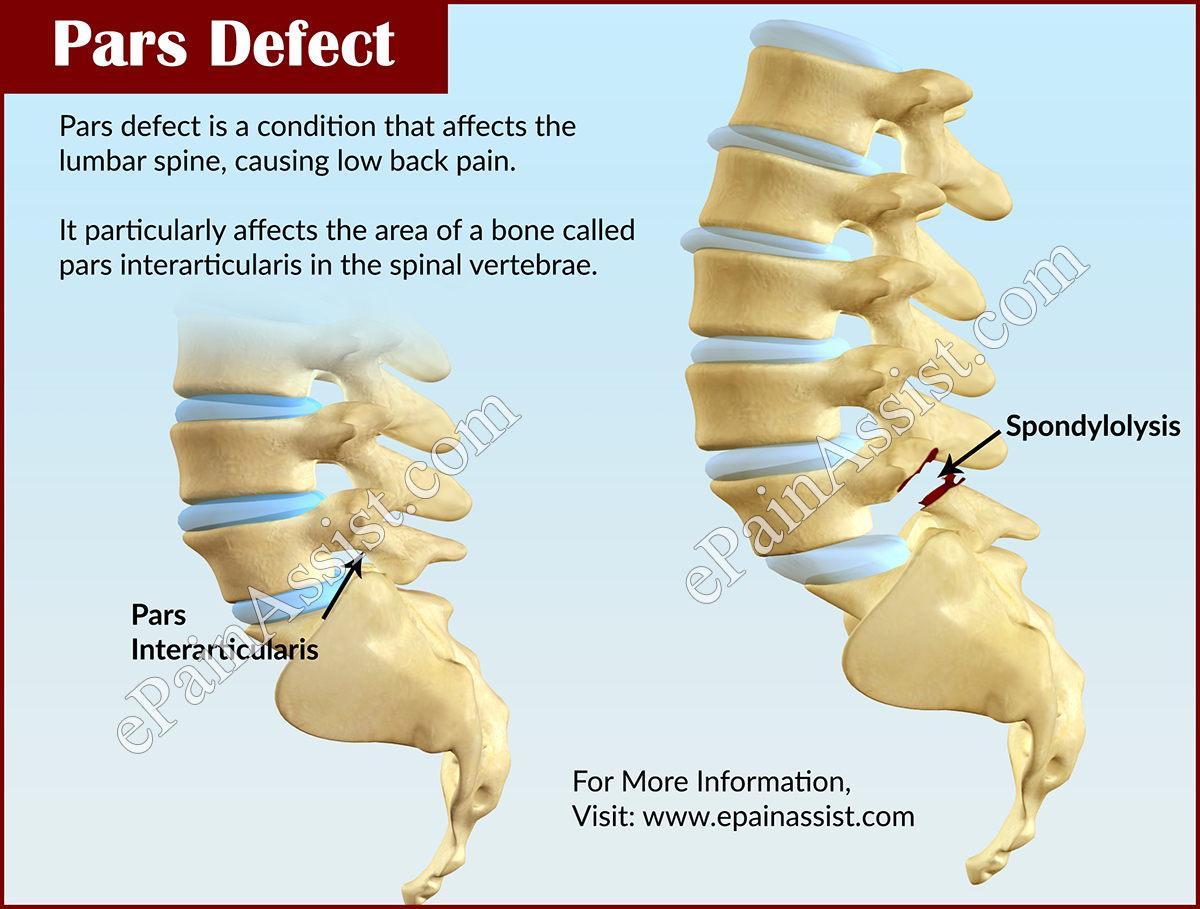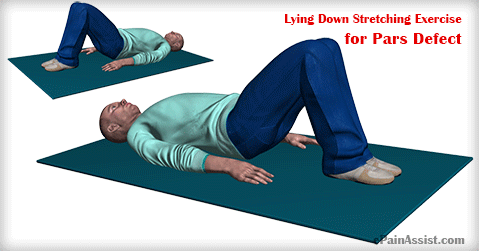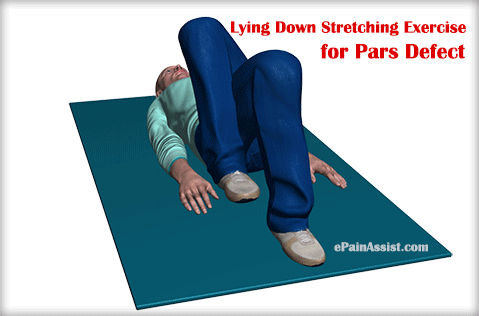Pars defect is a condition that affects the lumbar spine, causing low back pain. It particularly affects the area of a bone called pars interarticularis in the spinal vertebrae.

Pars Defect is also known as par interarticularis defect or pars fracture of the lumbar spine.
Pars Defect is one of the common causes of back pain in adolescents. Pars defect may be present since childhood without any presenting complaints. It may cause difficulties in some persons involved in sports, athletics and similar activities that demand rigorous movements of spine and particular hyperextension or back bending.
What is Pars Defect?
Pars defect occurs when there is a break in an area of the bone (pars interarticularis). Due to this, the upper and the lower portion of the vertebrae can get separated during repeated stress and strain on the spinal vertebra. Pars Defect can further develop into more bothersome conditions affecting the spine like slipping of the spinal vertebra. Pars defect can be considered as a risk factor for developing stress fractures and conditions like lumbar spondylosis or spondylolisthesis in some cases.
Pars defect on one side can cause pain and difficulty in spinal movements, more on the opposite side. However, the break can also occur in such a manner that it involves both sides of the vertebra; Pars defect involving both sides is called bilateral pars defect. This can increase the chances of the vertebral body splitting into two pieces. This is similar to a bone fracture and proper healing may not occur leading to a weak area, which is vulnerable to further stress and slipping of vertebra (spondylolisthesis). Pars defect of L5-S1 is common, in which this segment is frequently affected, which increases the risk of the L5 vertebra slipping over the S1 segment causing more damage. The L4-L5 segment too is common area, where Pars defect can lead to spinal problems.
Causes of Pars Defect
Pars defect, was earlier considered to be a birth defect, but later studies revealed that it is a break in the bone occurring due to undue pressure on the pars intercularis. The weak spot or break in that area can lead to complete breakage or damage to the vertebral bones by certain activities that cause repeated stress and strain.
- Athletics, gymnastics and sports activities cause more strain on the spine leading to Pars Defect.
- Certain sports like weight lifting, wrestling, ball games, tennis and dancing can cause repetitive and forceful stress on the vertebrae.
- Movements of the spine like hyperextension, extreme twisting or a combination of both exert stress on the pars.
Young players and athletics are at risk of overuse injuries while their skeletal system has not fully matured.
Symptoms of Pars Defect
Although young adults with Pars defect may be asymptomatic initially, an episode of injury or repeated stressful activities can cause back pain during their growth years. Low back pain is the most common presenting feature of Pars Defect. Pain associated with pars defect is usually sharp initially and may become dull in the chronic stage. Pain is often worse by activities, sports and is relieved by rest. In some sports persons, pain associated with pars defect may disappear temporarily during the rest period, but gradually reappear once the sports or stressful activities are resumed.
For any low back pain persisting for duration longer than 2 weeks, proper clinical evaluation is essential.
Diagnosis of Pars Defect
Pars defect may not be always visible on the X-rays, especially in the initial stages. Further advancement can be seen on X-rays, but healing in such cases can be difficult. Pars defect or the stress fracture can be detected using other imaging studies like MRI, CT scan or bone scan.
Treatment of Pars Defect
As Pars defect is considered as a stress injury or break in the bone, adequate rest, immobilization of the area, mechanical support and time can heal the condition. Pain medications for Pars defect are often advised depending on the condition, however, rest and proper healing is essential before resuming sports or other activities. Physical therapy for patients with pars defect can speed up the healing process. Physical therapy for pars defect would include use of warm and cold compresses, electrical stimulation, ultrasound, soft tissue massage, trigger point therapy, use of appropriate braces for back, hydrotherapy etc. This treatment modality can help relax the muscle in the surrounding area and relieve pain associated with pars defect.
A proper treatment plan for pars defect should be drawn with the help of an expert. It generally includes rest period, activity restrictions and use of back braces in initial period. Then active physical therapy like back strengthening exercises, training for flexibility and lumbar stabilization would follow in the treatment program for Pars defect. The final phase would include continuation of exercises and gradually resuming sports, if there is no pain.
Exercises for Pars Defect
The following exercises can be useful for patients with Pars Defect but these exercises should be done only after getting the approval from your treating physician or PT.
Lying Down Stretching Exercise for Pars Defect #1: Lie down on your back with your knees raised but with feet on the ground. Make sure your feet and your knee is held together. Slowly bend your knees to one side and simultaneously turn your head to the opposite side. Example if you are bending the knee to the left then your head should be turned to the right side. Stay in that position for 2-3 seconds and come back to the original position. Repeat the same step on the opposite side. Do this 10 times to each side provided the exercise is pain free.

Lying Down Stretching Exercise for Pars Defect #2: This exercise is similar to the one explained above but varies slightly and adds more flexibility to the spine. Lie down on your back with your knees raised but with feet on the ground. Make sure your feet and your knee is held together. Now, lift one leg up and keep it over the other leg, such that one knee is overlapping the other. Repeat the same steps as explained earlier. Slowly bend your knees to one side and simultaneously turn your head to the opposite side. Example if you are bending the knee to the left then your head should be turned to the right side. Stay in that position for 2-3 seconds and come back to the original position. Repeat the same step on the opposite side. Do this 10 times to each side provided the exercise is pain free.

Lying Down Stretching Exercise for Pars Defect #3: Lie down on your back with your knees raised but with feet on the ground. Make sure your feet and your knee are spread apart . Slowly bend your knees to one side and simultaneously turn your head to the opposite side. Repeat the same step on the opposite side. Do this 10 times to each side provided the exercise is pain free.

Pars Defect Exercise# 4- Knees to Chest: Lie down on your back and slowly get both your knees to the chest. You can use your hands to grab your knee so that it can come as close as possible to the chest. Repeat this exercise about 8 times as long as you are comfortable and do not experience any pain.

Prevention of Pars Defect
With advancement in medical technology, Pars defect, if detected early, appropriate measures can be taken to promote timely healing and further damage to the spine can be prevented. Patient education regarding proper posture, avoidance of stressful activities and importance maintaining regular fitness can also help.
Sports persons need to follow a proper fitness regimen, warm-ups, athletic conditioning and also take adequate breaks from their sports.
